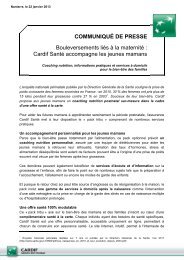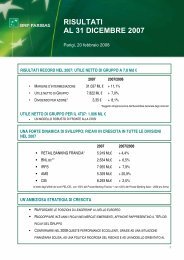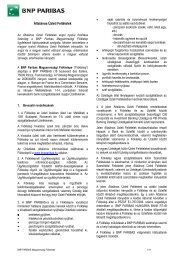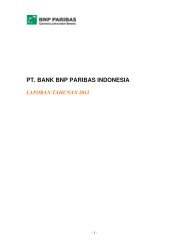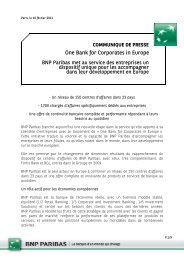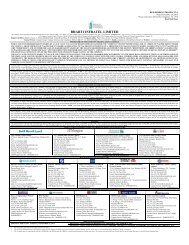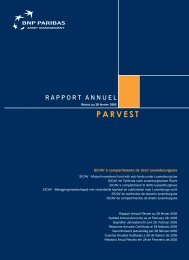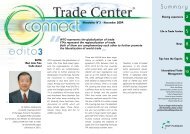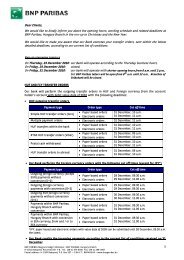INVESTMENT STRATEGY - BNP Paribas
INVESTMENT STRATEGY - BNP Paribas
INVESTMENT STRATEGY - BNP Paribas
You also want an ePaper? Increase the reach of your titles
YUMPU automatically turns print PDFs into web optimized ePapers that Google loves.
<strong>INVESTMENT</strong> <strong>STRATEGY</strong><br />
June 11, 2010<br />
June<br />
10<br />
At the crossroads<br />
ASSET ALLOCATION .................................... 2<br />
ECONOMIC OUTLOOK................................. 3<br />
Viewpoint .....................................................3<br />
Developed economies ...............................4<br />
Emerging markets ................................ 5<br />
BOND MARKETS.......................................... 6<br />
Government bonds....................................6<br />
IG and HY credit.........................................7<br />
CURRENCY MARKET ................................... 8<br />
EQUITY MARKETS....................................... 9<br />
Developed markets....................................9<br />
Emerging markets .................................. 11<br />
ALTERNATIVE STRATEGIES...................... 13<br />
Commodities ............................................ 13<br />
DISCLAIMER............................................... 14<br />
The last few weeks have seen markets grow increasingly nervous and<br />
pessimistic, with violent and sometimes bizarre reactions to economic data<br />
and policy decisions. Among all of the “noise” we must try to distinguish those<br />
issues that are truly important. The skittishness of investors may be attributed<br />
to the uncertain outlook over the coming months. Will growth continue, slow<br />
or perhaps even fall back into a double-dip recession? Will we see more<br />
systemic problems in the financial sector? Will plans to cut public spending be<br />
credible and effective? Can the euro zone stay together? According to our<br />
baseline scenario:<br />
- Growth will slow in the developed countries and efforts to reduce<br />
budget deficits will also start to make themselves felt in 2011. We<br />
do not expect this to trigger another recession however, since<br />
several factors should still continue to support modest growth,<br />
including investment, household consumption to a lesser extent<br />
and, in the case of Europe, exports.<br />
- Given the rescue plan implemented over the past few weeks, we<br />
currently see very little risk of a sovereign default in the euro zone<br />
or its collapse. Although this plan does not eliminate the longer-term<br />
risks it will help stabilise the situation.<br />
- Liquidity risk in the financial sector should not be overestimated, as<br />
the ECB and other central banks will certainly do everything<br />
necessary to prevent this.<br />
There are therefore indeed structural risks that will no doubt continue to weigh<br />
durably on risk appetite. Along with slower growth in the Western economies,<br />
these risks are likely to depress risky assets in these markets over the<br />
medium term. Nonetheless, with markets continuing to correct in May the<br />
current situation is rather complex. The global economy is growing, corporate<br />
profits are still rising and monetary policy will continue to be expansionary<br />
over the foreseeable future. Another factor is more attractive valuations for<br />
those asset classes that have declined since the beginning of the year. This is<br />
why we believe that risky asset prices are more likely to stabilise over the<br />
near term than drop sharply.<br />
Accordingly, we have stopped avoiding risk in June and our portfolio’s risk<br />
exposure is roughly unchanged from May. We are still neutral in developed<br />
market equities and continue to prefer the US market, although we have<br />
trimmed our underweight in the euro zone. We continue to wait for a better<br />
opportunity before returning to emerging markets. In the credit market we<br />
have maintained a slightly long position in the high-yield segment. In<br />
commodities, we have edged up our exposure to gold and other metals.
<strong>INVESTMENT</strong> <strong>STRATEGY</strong> JUNE 2010 - 2<br />
ASSET ALLOCATION<br />
Allocation decisions<br />
• Few changes since May.<br />
• Equities: neutral exposure to developed equities is maintained. Although we prefer emerging equities over<br />
the medium term their correlation with developed equities will mean similar exposure over the near term.<br />
• Bonds: we still prefer high-yield debt.<br />
• Commodities: waiting for an opportunity for oil, we still prefer gold.<br />
Developed equity markets<br />
• Still overweight in the US market and in the United Kingdom to a lesser extent.<br />
• Further trimming of euro-zone underweight.<br />
• Back to neutral in Japan.<br />
Emerging equity markets<br />
• Overweight in Korea and Russia.<br />
• A bit more optimistic about China.<br />
• Underweight in India, Brazil and South Africa.<br />
Typical diversified model portfolio – Institutional clients<br />
The model portfolio holdings below are measured against cash and may be transposed into any other<br />
portfolio whether benchmarked or not.<br />
MULTI‐ASSET CLASS 1 EQUITIES: DEVELOPED COUNTRIES 1 EQUITY EMERGING COUNTRIES 2<br />
Alpha Current Previous Alpha Current Previous Alpha Current Previous<br />
weight weight weight weight weight weight<br />
EQUITIES US 0.34 2.6% 2.4% Brazil ‐0.05 ‐0.2% ‐0.5%<br />
Developed Equities 0.03 0.4% 0.2% Canada ‐0.06 ‐0.5% ‐0.7%<br />
Emerging Equities 0.04 0.3% 0.6% Euroland ‐0.08 ‐0.7% ‐1.0% China 0.05 0.3% 0.0%<br />
FIXED INCOME Japan 0.00 ‐0.1% 1.2% India ‐0.10 ‐0.5% ‐0.5%<br />
Government Bonds ‐0.03 ‐1.4% 0.0% UK 0.09 0.7% 0.7% South‐Korea 0.13 0.9% 1.2%<br />
Investment Grade 0.01 0.2% ‐0.1% Switzerland ‐0.07 ‐0.6% ‐0.9% Taiwan 0.00 0.1% 0.3%<br />
High Yield 0.06 1.3% 1.7% Australia ‐0.22 ‐1.4% ‐1.7% Russia 0.15 0.7% 0.4%<br />
COMMODITIES<br />
Brent Oil 0.00 0.0% 0.0% South Africa ‐0.20 ‐1.4% ‐1.1%<br />
Base Metals 0.04 0.5% 0.3% Turkey 0.02 0.2% 0.1%<br />
Gold 0.08 0.7% 0.5% Module Total 0.0 0.0% 0.00% Module Total 0.0 0.0% 0.0%<br />
Agricultural 0.00 0.0% 0.0%<br />
Cash Euro ‐1.9% ‐3.4% BOND COUNTRIES SOVEREIGN 1<br />
Module Total 0.0% 0.0% Alpha Current Previous<br />
weight weight<br />
PORTFOLIO STATISTICS US 0.0 ‐1.2% ‐7.0%<br />
Target Ex‐ante Volatility 1.00% Euroland 0.5 9.5% 6.4%<br />
Real Ex‐ante Volatility 0.66% Japan 0.0 ‐1.2% ‐4.8%<br />
UK ‐0.5 ‐6.1% ‐0.7%<br />
Switzerland 0.0 ‐1.2% 6.1%<br />
1‐Hedged in Euro, 2‐Local Currency Module Total 0.0 0.0% 0.00%
<strong>INVESTMENT</strong> <strong>STRATEGY</strong> JUNE 2010 - 3<br />
ECONOMIC OUTLOOK<br />
Viewpoint<br />
A more difficult environment<br />
Sovereign debt crisis is<br />
key concern now...<br />
...and for the future<br />
The rescue plan is credible but fails to convince. Over the past few weeks<br />
concerns about European sovereign debt have captured the attention of investors<br />
and caused them to ignore some rather encouraging indicators in the United<br />
States and the emerging economies and upward revisions in earnings forecasts.<br />
Markets remain jittery, despite the announcement by European authorities of a<br />
massive rescue and stabilisation plan that should, at least in theory, ease liquidity<br />
risk. The fact that national lawmakers were quick to approve the creation of a<br />
European financial stability fund further strengthens the plan’s credibility. Lastly,<br />
the ECB’s decision to purchase government bonds reduces the risk of further<br />
attacks by speculators. Yet despite these factors volatility continues to be high in<br />
comparison with late April and the euro remains weak. We feel this situation<br />
reflects the growing awareness of the increasingly structural nature of<br />
sovereign debt risk that is the consequence of fiscal stimulus measures and the<br />
recession.<br />
Sluggish growth ahead<br />
Risks have intensified<br />
Macroeconomic concerns are likely to return to the forefront as efforts to<br />
redress public finances weigh on growth. There is little chance that countries that<br />
are not under direct pressure from financial markets will begin fiscal<br />
consolidation in 2010, given upcoming elections and the time required to adjust<br />
fiscal policy. And yet some countries (most notably Germany) have already made<br />
commitments toward greater fiscal discipline as of 2011. During this transition<br />
toward less expansionary policy economic news is likely to become increasingly<br />
disappointing as the manufacturing cycle’s boost to economic activity runs its<br />
course and growth slows to a modest pace. We may then expect only a very<br />
gradual improvement in the labour market that will leave the jobless rate quite<br />
high.<br />
We maintain our scenario of slower growth over the coming quarters in the<br />
Western countries, whose economies should however continue to recover. Yet the<br />
risk of more than just a slowdown, i.e. a double-dip recession, is now probably<br />
higher. The race to cut public deficits would severely handicap growth, while<br />
recent strains in European interbank markets could reduce the supply of credit if<br />
they continue and intensify. These threats would play out against a background of<br />
steadily declining core inflation (less than 1% in Europe and the US) that has<br />
rekindled fears of deflation. Both recession and deflation (which our baseline<br />
scenario excludes) would be particularly difficult to deal with, given the limited<br />
scope for economic policy measures.<br />
Consensus Forecasts: Growth & Inflation<br />
GDP y.o.y % Inflation y.o.y %<br />
2009 2010 2011 2009<br />
2010 2011<br />
M= Mean; H= High; L=Low M H L ‐1M M H L ‐1M M H L ‐1M M H L ‐1M<br />
Developed Economies<br />
USA ‐2.4 3.3 3.9 2.9 [3.2] 3.1 4.4 1.9 [3.1] ‐0.3 2.0 2.6 1.6 [2.1] 1.9 3.8 0.6 [1.9]<br />
Canada ‐2.6 3.3 3.7 2.5 [3.2] 3.0 3.6 2.1 [3.0] 0.3 1.9 2.1 1.6 [1.9] 2.2 2.6 1.7 [2.2]<br />
Euro zone ‐4.0 1.1 1.7 0.7 [1.2] 1.5 2.6 0.9 [1.5] 0.3 1.3 1.6 1.0 [1.2] 1.4 1.9 0.8 [1.4]<br />
UK ‐4.9 1.3 2.2 0.8 [1.3] 2.3 3.4 1.1 [2.3] 2.2 2.9 3.2 2.2 [2.7] 1.8 3.6 0.3 [1.7]<br />
Switzerland ‐1.5 1.9 2.5 0.9 [1.8] 1.9 2.8 1.2 [1.9] ‐0.5 1.0 1.3 0.3 [1.0] 1.0 1.5 0.5 [1.1]<br />
Japan ‐5.2 2.4 3.2 1.7 [2.2] 1.7 2.9 0.9 [1.6] ‐1.4 ‐1.0 ‐0.6 ‐1.4 ‐[1.1] ‐0.2 0.4 ‐0.7 ‐[0.2]<br />
Australia 1.3 3.2 3.8 2.6 [3.3] 3.4 4.3 2.7 [3.4] 1.8 2.8 3.4 2.4 [2.6] 2.9 3.8 2.6 [2.8]<br />
Source: Consensus Forecasts as of 10/05/2010
<strong>INVESTMENT</strong> <strong>STRATEGY</strong> JUNE 2010 - 4<br />
ECONOMIC OUTLOOK<br />
Developed economies<br />
Growth has been spotty and will probably remain so<br />
Americans consume,<br />
the Japanese export<br />
and Europeans are<br />
depressed<br />
Euro zone continues to<br />
lag<br />
The US economy is<br />
growing but will<br />
probably slow in the<br />
second half<br />
Central bankers must<br />
continue to provide<br />
support<br />
Although the aggregate GDP growth of the OECD countries has been positive for<br />
the past four quarters some are growing significantly faster than others. They may<br />
be divided into three groups: those where domestic demand is satisfactory or even<br />
robust (the United States and Canada), those who continue to export (Japan and<br />
Switzerland), and Europe (including the UK) where household consumption<br />
remains sluggish and imports rose in the 1 st quarter. This situation is likely to<br />
continue and even intensify in the second half of the year when economic activity<br />
slows from the relatively rapid pace we have been seeing since the fourth quarter<br />
(from 0.9% then 0.7% q/q in the OECD area).<br />
In the euro zone, growth forecasts are being steadily lowered, including by the<br />
ECB, which now expects only 1.2% in 2011. The euro’s depreciation does not make<br />
up for the currency block’s structural sovereign debt concerns, high<br />
unemployment, weak consumption and the prospect of greater fiscal discipline.<br />
Business investment in countries with strong export demand may be restricted if<br />
credit remains tight.<br />
In the United States, although growth is gradually becoming self-sustaining it is<br />
likely to remain limited. Household consumption has been maintained by social<br />
transfers and a lower saving rate. Although wage growth is expected to accelerate<br />
over the next few months, when temporary census-related hiring is excluded the<br />
labour market’s recovery has been weak. The jobless rate (9.8% in May) is not<br />
likely to decline over the near term and this could weigh on consumer confidence<br />
and spending. Judging from survey data and indicators, manufacturing activity is<br />
probably near its peak but will not collapse. Although business investment may<br />
pick up the slack relatively little is expected from SME, as is the case with job<br />
creation. Yet GDP in the 2 nd quarter should benefit from investment to replace<br />
equipment and the pick-up in the housing market in April. Although this<br />
improvement may largely be attributed to favourable tax measures, housingrelated<br />
spending (on durable goods, furniture, etc.) should increase. GDP growth<br />
should therefore be comparable to the annualised 3% seen in the 1 st quarter and<br />
then gradually decline.<br />
Even though the economy has improved over the past few months it is still fragile<br />
and the Federal Reserve and the ECB should definitely maintain their highly<br />
accommodative monetary policies as financial stress returns to credit markets.<br />
United States – weak signals of a slowdown<br />
Euro zone – domestic demand is weak<br />
8<br />
115.<br />
17,000<br />
Euroland: Unemployed Persons and Households Expectations<br />
80<br />
6<br />
4<br />
110.<br />
105.<br />
16,000<br />
70<br />
60<br />
2<br />
0<br />
100.<br />
95.<br />
15,000<br />
14,000<br />
50<br />
40<br />
30<br />
‐2<br />
90.<br />
13,000<br />
20<br />
‐4<br />
‐6<br />
00 01 02 03 04 05 06 07 08 09 10<br />
Conference Board Leading Indicator (2004=100) (Right)<br />
6‐month change in Leading Indicator (Left)<br />
Real GDP, y/y % change (Left)<br />
85.<br />
80.<br />
Source: Factset, <strong>BNP</strong>P AM<br />
12,000<br />
11,000<br />
‐10<br />
95 96 97 98 99 00 01 02 03 04 05 06 07 08 09 10<br />
Unemployment Overall Total, Persons, SA ‐ Euro Zone (Left)<br />
Consumer surveys Unemployment expectations over the next 12 months (Right)<br />
Source: Factset, <strong>BNP</strong>P AM<br />
10<br />
0
<strong>INVESTMENT</strong> <strong>STRATEGY</strong> JUNE 2010 - 5<br />
ECONOMIC OUTLOOK<br />
Emerging markets<br />
Growth stops accelerating but is still robust<br />
Growth still solid in<br />
the emerging<br />
economies<br />
Unlike the G7<br />
members, the<br />
emerging economies<br />
have very little debt<br />
Higher wages<br />
accelerate the<br />
rebalancing of China's<br />
economy<br />
Supported by domestic demand, economic recovery in the emerging<br />
countries has been particularly strong and is likely to remain so over the<br />
coming quarters. But as we pointed out last month, Brazil and many countries<br />
in Asia have reached their growth potential and we may now expect slower<br />
growth from the emerging economies. Recent business surveys also suggest<br />
that the pace of global economic activity is likely to stabilise over the summer.<br />
Indeed, with the exception of India, emerging countries’ purchasing manager<br />
indices are down substantially, although still well within expansion territory.<br />
This may mainly be attributed to fewer new orders and the global economy’s<br />
adverse impact on manufacturing.<br />
Although the emerging economies should be relatively unscathed by Europe's<br />
difficulties, their policy decisions must now factor in the greater risk of a<br />
slowdown in demand from their developed counterparts and in the growth of<br />
the global economy. Asia, where budgets are soundest, is in the best position<br />
to withstand contagion. Among the Eastern countries, Russia's low public and<br />
foreign debt should best enable it to weather the current crisis, which has<br />
already affected Hungary considerably. The main risk for Brazil is a fall in<br />
commodity prices.<br />
With 11.9% GDP growth in Q1, China's economic cycle has probably peaked.<br />
Property sales have fallen sharply in the wake of new administrative<br />
measures and now cast a cloud over the construction sector, while the latest<br />
PMI index also points to a slowdown in export orders. These signals should<br />
justify a pause in monetary tightening. Chinese authorities have decided to<br />
accelerate the rebalancing of the country's economy by raising minimum<br />
wages. The sharp salary increases granted by Foxconn and Honda in response<br />
to both social and demographic factors will reverse the downward trend in<br />
wage income relative to GDP, reduce the saving rate and thereby boost<br />
household consumption's contribution to economic activity. Less dependence<br />
on foreign trade and investment is reducing the economy's cyclicality and<br />
volatility.<br />
EM – strong domestic growth<br />
China – growth has peaked<br />
40<br />
Retail Sales (annual percentage change)<br />
65<br />
13<br />
30<br />
60<br />
12<br />
20<br />
10<br />
0<br />
55<br />
50<br />
45<br />
Previous fcts<br />
Latest fcts<br />
11<br />
10<br />
9<br />
8<br />
‐10<br />
Jan‐05<br />
Apr‐05<br />
Jul‐05<br />
Oct‐05<br />
Jan‐06<br />
Apr‐06<br />
Jul‐06<br />
Oct‐06<br />
Jan‐07<br />
Apr‐07<br />
Jul‐07<br />
Oct‐07<br />
Jan‐08<br />
Apr‐08<br />
Jul‐08<br />
Oct‐08<br />
Jan‐09<br />
Apr‐09<br />
Jul‐09<br />
Oct‐09<br />
Jan‐10<br />
40<br />
7<br />
30<br />
05 06 07 08 09 10 11<br />
5<br />
‐20<br />
35<br />
6<br />
World Advanced economies Emerging economies Emerging Asia<br />
GDP YoY (RIGHT)<br />
PMI
<strong>INVESTMENT</strong> <strong>STRATEGY</strong> JUNE 2010 - 6<br />
BOND MARKETS<br />
Government bonds<br />
Guarantees fail to calm nervous investors<br />
Europe spares nothing<br />
to stop the sovereign<br />
debt crisis<br />
To make sure that it was taken seriously when it announced its measures to<br />
alleviate the funding difficulties of some EU members, the European Union<br />
committed a substantial amount of funds and ensured that the ECB would<br />
play an active role. The central bank had previously been reluctant to adopt<br />
certain unorthodox measures. Although the market's immediate and justifiable<br />
perception was that the plan was a good one, investors soon began to find<br />
other reasons to worry beyond the euro zone and its sovereign debt crisis,<br />
such as slower growth in the emerging economies, new banking regulations<br />
and macroeconomic uncertainties.<br />
However, it is easy to find arguments to counter each of these concerns. As is<br />
often the case, the truth no doubt lies somewhere in between.<br />
Given the sluggish growth and the long-term threat of sovereign risk, we<br />
believe these structural concerns will be around for quite some time. But<br />
for the time being, the measures taken should normally enable markets to<br />
breathe a bit easier, yet this has not been the case. Bond investors thus<br />
continue to flee the riskier countries as they seek refuge in German Bunds<br />
and US Treasuries, as may be seen by further pressure on Spanish and Italian<br />
yields.<br />
A technical correction<br />
is possible but yields<br />
will stay low<br />
We believe this reaction is excessive. It is mainly driven by sentiment and is<br />
therefore susceptible to a sudden reversal if German and US yields<br />
"normalise" at somewhat higher levels.<br />
Even if such a correction would mean more reasonable valuations, we are<br />
unlikely to see any spectacular increase in yields. Indeed, they will<br />
probably remain rather low over the next few months given the prospect of<br />
weak growth, the downward trend in core inflation and the maintenance of<br />
rock-bottom policy interest rates for the foreseeable future.<br />
Spanish and Italian 10-year spreads over Bunds<br />
at record level<br />
2-year German Bunds are overbought<br />
2.0<br />
1.8<br />
EMU countries 10 year spreads vs Bund<br />
250<br />
140<br />
1.6<br />
200<br />
120<br />
1.4<br />
1.2<br />
150<br />
100<br />
80<br />
1.0<br />
100<br />
60<br />
0.8<br />
0.6<br />
50<br />
40<br />
0.4<br />
Jan‐10 Feb‐10 Mar‐10 Apr‐10 May‐10<br />
Italy Spain<br />
0<br />
janv.‐06<br />
avr.‐06<br />
juil.‐06<br />
oct.‐06<br />
janv.‐07<br />
avr.‐07<br />
juil.‐07<br />
oct.‐07<br />
janv.‐08<br />
avr.‐08<br />
juil.‐08<br />
oct.‐08<br />
janv.‐09<br />
avr.‐09<br />
juil.‐09<br />
oct.‐09<br />
janv.‐10<br />
avr.‐10<br />
20
<strong>INVESTMENT</strong> <strong>STRATEGY</strong> JUNE 2010 - 7<br />
BOND MARKETS<br />
IG and HY credit<br />
Worries remain despite stronger fundamentals<br />
Since they suffer from the same fears that have lowered German and US interest<br />
rates, credit markets have also declined. The spreads of investment-grade debt<br />
issued in euros have widened, particularly on financial sector issuers. However,<br />
since this is mainly attributable to lower benchmark interest rates there was<br />
little impact on yields and losses were relatively modest, except of course on<br />
subordinated debt.<br />
New issuance plunges<br />
Concerns about certain countries and consequently certain financial institutions<br />
weighed on credit markets, not only by increasing spreads but by making it more<br />
difficult to issue new debt. With only a few exceptions, primary market issuance<br />
has fallen sharply and the ECB's programmes were the only means that some<br />
borrowers had to obtain short-term funds.<br />
Although this has had no major impact on borrowing costs in euros, some strains<br />
were observed across the Atlantic, particularly in the form of a broader Libor-OIS<br />
spread as some European banks had difficulty in obtaining dollar funding. We<br />
believe however that these fears are exaggerated, given the size of the spread, the<br />
measures implemented to ensure liquidity and the relatively little use that has<br />
been made of the dollar funding made available by the Central Bank.<br />
Unsurprisingly, high-yield issues were hit harder than investment grade.<br />
Although the decline in performance relative to the recent high is not in itself<br />
alarming, the volume of HY fund redemptions is another matter, since fund<br />
inflows have been a very strong supporting factor.<br />
High-yield fund<br />
redemptions remove a<br />
major support<br />
Barring a reversal of risk aversion, it is hard to imagine investors rushing back<br />
to HY debt. However, we prefer to maintain our overweight in the highyield<br />
segment, given the unlikely prospect of a relapse into recession,<br />
increasingly strong fundamentals, fewer defaults, a relatively attractive carry<br />
yield and the lack of compelling alternatives.<br />
Primary European IG market shuts down<br />
High-yield investment funds chalk up<br />
redemptions<br />
Financials<br />
Source: Citigroup
<strong>INVESTMENT</strong> <strong>STRATEGY</strong> JUNE 2010 - 8<br />
CURRENCY MARKET<br />
The euro should stop falling but a durable rebound is unlikely<br />
More volatile euro<br />
struggles to regain<br />
ground<br />
Rumours of<br />
intervention<br />
The euro will be weak<br />
over the medium term<br />
Japan's new prime<br />
minister favours a<br />
weaker yen<br />
Will the G7 or G20<br />
take action?<br />
In response to recent developments in the sovereign debt crisis, the euro has<br />
dropped sharply since the end of April against the US dollar (by 9% on June<br />
10), the yen (-12%) and a basket of currencies (-6%). Various events and<br />
rumours have weighed on Europe's currency, which benefited only<br />
momentarily from the announcement of the European stabilisation plan,<br />
falling rapidly back down after an initial surge. Germany's unilateral decision<br />
on May 18 to prohibit certain types of short sales rekindled concerns that<br />
Europe's cohesion could fall to pieces and caused the single currency to slump<br />
below 1.22 USD. The low level to which the EUR/USD rate has fallen triggered<br />
rumours of intervention that enabled the euro to recover to 1.26 on May 21.<br />
Other factors also came into play, such as the announcement by Chinese<br />
authorities that they would, contrary to rumours, continue to purchase euros<br />
to diversify their foreign reserves. The SNB's purchases on May 18 to prevent<br />
the EUR/CHF rate from falling below 1.40 and a timid increase in risk appetite<br />
also helped strengthen the euro, which is still extremely volatile however. In<br />
early June, EUR/USD fell below 1.20 as investors reacted nervously to<br />
statements by a Hungarian official.<br />
The conditions for a near-term euro recovery are in place (European<br />
solidarity and the prospect of less risk aversion and speculation) and should<br />
prevent further weakening of the EUR/USD rate, which is now near its<br />
equilibrium value. We expect the downward trend to reappear toward the end<br />
of the year and assert itself in 2011, when greater importance is accorded to<br />
more fundamental factors, such as economic growth and monetary policy.<br />
Expect a weaker yen by the end of year. When he was finance minister,<br />
Naoto Kan made it known that currency intervention was an option, stating<br />
that he wanted to avoid an "excessive increase" in the yen. Now that he is<br />
prime minister this is what he is likely to encourage the BoJ to do. The<br />
maintenance of highly accommodative monetary policy and the decision to<br />
provide one-year loans to banks could facilitate the revival of yen-financed<br />
carry trades, although investors will first have to regain some appetite for risk.<br />
The levels that some currencies have reached, the high volatility and the<br />
threat that sharp fluctuations might pose to economic activity could<br />
encourage officials to normalise the currency market. Central banks certainly<br />
already have quite a bit to deal without a currency crisis. The currency game<br />
has entered a political phase that could signal the end of play.<br />
FX Rate Forecast Summary (Major Currencies)<br />
End of Period<br />
2Q 2010 3Q 2010<br />
4Q 2010 1Q 2011<br />
2009 10-Jun-10<br />
Min Max Min Max Min Max Min Max<br />
USD Block EUR / USD 1.43 1.2057 1.20 1.30 1.20 1.30 1.20 1.25 1.15 1.20<br />
USD / JPY 93 91.47 90 100 95 100 100 105 100 110<br />
USD / CAD 1.05 1.0381 0.95 1.05 0.95 1.05 1.00 1.10 1.00 1.10<br />
AUD / USD 0.90 0.8340 0.85 0.90 0.82 0.87 0.82 0.87 0.85 0.90<br />
GBP / USD 1.61 1.4594 1.39 1.56 1.47 1.56 1.44 1.53 1.38 1.47<br />
USD / CHF 1.03 1.1429 1.10 1.14 1.10 1.14 1.14 1.18 1.19 1.23<br />
EUR Block EUR / JPY 134 110.29 113 125 119 125 123 129 118 129<br />
EUR / GBP 0.89 0.8262 0.80 0.90 0.80 0.85 0.80 0.85 0.80 0.85<br />
EUR / CHF 1.48 1.3780 1.38 1.43 1.38 1.43 1.40 1.45 1.40 1.45<br />
Source: <strong>BNP</strong>P AM as of 10/6/2010
<strong>INVESTMENT</strong> <strong>STRATEGY</strong> JUNE 2010 - 9<br />
EQUITY MARKETS<br />
Developed markets<br />
Increasing risk of a downturn<br />
A cyclical slowdown is<br />
taking shape...<br />
... and will cause<br />
disappointment just as<br />
doubts about the<br />
sustainability of<br />
growth intensify<br />
The very buoyant conditions in equity markets have been deteriorating<br />
over the past few weeks. The leading global economic indicators that we<br />
monitor have confirmed their downward trend and consequently our<br />
scenario of slower global growth in the second half of the year. However,<br />
we do not expect the global economy to fall back into recession, given the<br />
resilience of US economic activity made possible by still favourable fiscal policy in<br />
2010, and above all the robust growth of the emerging countries. Furthermore,<br />
monetary conditions will continue to be particularly favourable in the advanced<br />
economies over the next few quarters. The cyclical slowdown now taking shape<br />
will not in itself prevent equity prices from rising. Nonetheless, the imminent<br />
decline in GDP growth, which has yet to be confirmed by the most recent<br />
economic data, will occur in an environment that is particularly unfavourable and<br />
stressful for equity markets.<br />
Recent strains on the sovereign debt of some countries indeed remind us that the<br />
repercussions of the subprime crisis are still making themselves felt in the form of<br />
tighter credit markets, accelerated fiscal tightening and diminished confidence<br />
that will continue to weigh on global growth for several years.<br />
This resurgence of doubt as to the sustainability of growth will be exacerbated by<br />
the "cyclical" disappointments that we may expect very soon. The extremely<br />
favourable ratio of positive surprises for both economic news and corporate<br />
earnings is therefore likely to reverse trend very shortly. This will revive concerns<br />
of a more structural nature about global growth, in light of the considerable<br />
imbalances that remain in the global economy, not least of which are household<br />
and public debt.<br />
Since news flow is very likely to be disappointing and often plays a greater role in<br />
near and medium-term market performance than fundamentals themselves, we<br />
expect it to become an increasingly negative factor over the coming months.<br />
For the time being, the earnings growth trend is still quite positive and the<br />
second-quarter earnings season could even still be surprisingly strong.<br />
Leading indicators have reversed already<br />
Profit margin forecasts are<br />
very (over?) optimistic<br />
100<br />
90<br />
80<br />
70<br />
60<br />
50<br />
40<br />
30<br />
20<br />
10<br />
0<br />
Breadth of Leading Indicators: % of countries with improving momentum<br />
75 76 77 78 79 80 81 82 83 84 85 86 87 88 89 90 91 92 93 94 95 96 97 98 99 00 01 02 03 04 05 06 07 08 09 10<br />
Leading of LEIs (% countries with rising 2m momentum) ‐ advanced by 4M (LHS)<br />
OECD LEI for the G7 ‐ 12m% changes (RHS)<br />
Source: OECD, Datastream, <strong>BNP</strong>P AM<br />
12.5<br />
10.0<br />
7.5<br />
5.0<br />
2.5<br />
0.0<br />
‐2.5<br />
‐5.0<br />
‐7.5<br />
‐10.0<br />
‐12.5<br />
‐15.0<br />
10<br />
9<br />
8<br />
7<br />
6<br />
5<br />
4<br />
S&P500 ex. Financials: Margins (%)<br />
95 96 97 98 99 00 01 02 03 04 05 06 07 08 09 10e 11e 12e<br />
Worlscope ‐ median estimates IBES estimates<br />
15‐year average (worldscope)<br />
Source: Datastream, IBES, Worldscope, <strong>BNP</strong>P AM
<strong>INVESTMENT</strong> <strong>STRATEGY</strong> JUNE 2010 - 10<br />
EQUITY MARKETS<br />
Developed markets<br />
Highly favourable<br />
earnings forecasts are<br />
at risk<br />
However, earnings growth will have some headwinds to face. To begin with, fiscal<br />
tightening is likely to gradually weigh on sales as the potential to further increase<br />
profit margins steadily diminishes. Furthermore, financial sector earnings will<br />
probably suffer from recent market developments and their negative impact<br />
on funding conditions. Given these factors, current forecasts of sales and<br />
earnings growth, and the profit margins they imply, seem quite optimistic. In<br />
addition, the momentum of upward earnings forecast revisions is at an historically<br />
high level. This trend could therefore quite easily reverse over the coming months<br />
and disappoint investors, which poses an additional and major threat to equities.<br />
With this in mind, the currently attractive level of valuations (which are<br />
particularly compelling when based on forward 12-month P/E) should be<br />
considered with caution. Furthermore, given the increasingly uncertain outlook<br />
for growth and the resurgence of fears of near-term deflation and long-term<br />
inflation, valuations are likely to play a lesser role in investment decisions. We<br />
therefore have a cautious medium-term outlook on equities, although a<br />
technical rebound may be expected in the short run.<br />
We prefer the United<br />
States<br />
The main change in our geographic allocation this month is a shift from<br />
overweight to neutral in the Japanese market, where economic and political<br />
uncertainties offset the positive earnings revision trend and relatively attractive<br />
valuations. We remain overweight in US equities given the high level of risk<br />
aversion and the still favourable near-term outlook for earnings, despite the<br />
dollar's appreciation. We have maintained a slightly overweight position in British<br />
equities in view of UK monetary policy measures and their very compelling<br />
relative valuations. However, the pound's strong appreciation against the euro and<br />
uncertainties about the new budget plan limit our enthusiasm. We have once<br />
again trimmed our underweight in euro-zone equities to account for the<br />
favourable impact of the euro's decline on exports and repatriated earnings. Yet<br />
this market remains handicapped by the region's structural challenges, concerns<br />
about bank exposure to peripheral countries and the implementation of fiscal<br />
austerity despite the current recovery's fragility.<br />
Valuations are attractive, if you believe<br />
EPS forecasts<br />
The weaker euro's positive impact on EPS<br />
(USBD10Y-PCH#(USCP....F,1Y)) 4/6/10<br />
20 120<br />
12‐Month valuation<br />
32<br />
30<br />
28<br />
26<br />
24<br />
22<br />
20<br />
18<br />
16<br />
14<br />
12<br />
10<br />
8<br />
6<br />
88 89 90 91 92 93 94 95 96 97 98 99 00 01 02 03 04 05 06 07 08 09 10<br />
cyclically adjusted trailing P/E ‐ MSCI World LT Avg<br />
12‐Month Forward P/E ‐ MSCI World LT Avg +/‐ 1 stdev Source: Factset, MSCI, <strong>BNP</strong>P<br />
10<br />
‐10<br />
‐20<br />
‐30<br />
‐40<br />
0<br />
‐50<br />
2005 2006 2007 2008 2009 2010<br />
EPS REVISION BREADTH, MSCI EMU<br />
TRADE WEIGHTED EURO, FORWARDED BY 6 MONTHS(R.H.SCALE)<br />
Source: Thomson Datastream<br />
125<br />
130<br />
135<br />
140<br />
145<br />
150<br />
155<br />
160
<strong>INVESTMENT</strong> <strong>STRATEGY</strong> JUNE 2010 - 11<br />
EQUITY MARKETS<br />
Emerging markets<br />
Superior performance with lower beta<br />
Leading indicators<br />
suggest no reversal for<br />
a few months<br />
Outperformance and<br />
low beta<br />
Leading indicators continue to decline. This has been the trend since fall<br />
2009 and it will continue for a few more months. The tightening of monetary<br />
policy, which is just underway in Brazil, India and many other countries, is<br />
likely to continue. However, the sluggishness of the global economy (further<br />
weakened by the sovereign debt crisis) reduces the threat of runaway inflation<br />
and therefore of the increase in market volatility normally observed during<br />
periods of rising interest rates. Other indicators are also unfavourable, such as<br />
the semiconductor cycle and the ratio of inventories to shipments.<br />
Lastly, the normalisation of China's economy from excessive growth to high<br />
growth will not be good for commodities and this could throw a damper on<br />
such markets as Brazil, Russia and India, to a lesser extent. The sharp drop in<br />
the Australian dollar clearly reflects this outlook.<br />
The performance of the emerging equity markets has historically been<br />
strongly correlated with the global economy, the Federal Reserve's<br />
monetary policy and investment fund flows. This explains their high betas<br />
and the extreme swings in emerging indices during times of financial crisis in<br />
comparison with developed market indices. Yet the opposite has strangely<br />
been the case since Europe's sovereign debt crisis, with emerging markets<br />
outperforming developed by 4.3% (in local currency terms), despite their<br />
current monetary tightening. The relative volatility of emerging markets<br />
versus developed has even decreased. Furthermore, the dollar's appreciation<br />
in response to heightened risk aversion did not weigh on emerging equity<br />
prices as expected. If this trend continues, it will be tempting to conclude that<br />
emerging markets offer superior growth and a lower beta, which is an ideal<br />
combination for any portfolio. This is not yet the case however in terms of<br />
absolute performance, since many risks still lie ahead, such as the decline of<br />
Chinese leading indicators and further monetary tightening. We do not expect<br />
the market trend to clearly start reversing before one or two quarters, when<br />
leading indicators hit bottom.<br />
Higher rates, weak performance<br />
EM – outperformance with less risk<br />
MSCI Index Return (%)<br />
50<br />
45<br />
40<br />
35<br />
30<br />
25<br />
20<br />
15<br />
10<br />
5<br />
0<br />
Regional performance in the four stages of an upturn,<br />
since 1998<br />
Bounce<br />
Earnings<br />
Recovery<br />
Tightening<br />
Euphoria<br />
Global USA Europe Japan Asia Pac xJ GEM<br />
140<br />
0.60<br />
0.55<br />
135<br />
0.50<br />
130<br />
0.45<br />
125<br />
0.40<br />
120<br />
0.35<br />
115<br />
0.30<br />
0.25<br />
110<br />
0.20<br />
105<br />
0.15<br />
100<br />
0.10<br />
95<br />
0.05<br />
J J A S O N D J F M A M J J A S O N D J F M A M<br />
REL PERF EM vs DM<br />
VOLATILITY EM (LOCAL)(R.H.SCALE)<br />
VOLATILITY DM (LOCAL)(R.H.SCALE)<br />
Source: DATASTREAM
<strong>INVESTMENT</strong> <strong>STRATEGY</strong> JUNE 2010 - 12<br />
EQUITY MARKETS<br />
Emerging markets<br />
Does peak stress = a<br />
low point?<br />
Back to a slight<br />
overweight in China<br />
From a technical standpoint, emerging indices are once again sitting on a<br />
major support level. Stress indicators also peaked in late May, which<br />
confirms the near-term bull trend. As for valuations, the combination of the<br />
upward trend in earnings forecast revisions and recent market corrections<br />
have brought valuation multiples well below their historical averages. Lastly,<br />
we should keep in mind that emerging markets’ firms are less indebted than<br />
their counterparts in the developed economies, which further enhances their<br />
appeal.<br />
After a massive inflow of funds in 2009, the increase in risk aversion will<br />
reduce investments in emerging markets to more modest levels this year.<br />
Unsurprisingly, only the EMEA region enjoys a net inflow so far this year, with<br />
undiscriminating global EM funds, such as ETFs, responsible for most of the<br />
demand.<br />
We are back up to a slight overweight in China. Property sales have<br />
plunged in reaction to the drastic measures adopted in mid-April. The 40%<br />
drop in transactions over one month could cause officials to suspend<br />
monetary tightening to prevent a self-sustaining decline in the market that<br />
could hurt consumer confidence. The most recent figures already show an<br />
encouraging stabilisation of bank lending and M1 money supply growth.<br />
Exports are also surprisingly strong, suggesting that China's economy is<br />
showing good resilience in the depressed global environment. The first major<br />
emerging equity market to start consolidating in the summer of 2009, China's<br />
could also be the first to revive. This at least seems to be what Chinese<br />
authorities believe since they still plan to go ahead this summer with the<br />
Agricultural Bank of China's IPO, which is poised to be one of the largest ever.<br />
Technical factors are compelling and portfolios have too much cash.<br />
Although economic and financial conditions are still attractive, we are<br />
reducing our exposure to Korea in light of the heightened geopolitical risk.<br />
We are maintaining a very small underweight in Brazil in response to<br />
monetary tightening, even though positive earnings revisions have reduced<br />
valuations to more normal levels. Despite India's long-term structural<br />
appeal given its huge potential domestic demand, we are cautious about this<br />
market since it is still too expensive over the near term and monetary<br />
tightening has just begun.<br />
China – a strong link between lending and<br />
performance<br />
1600<br />
Brazil – valuations are back to neutral<br />
14<br />
40<br />
1400<br />
13<br />
35<br />
30<br />
25<br />
20<br />
?<br />
1.9<br />
1.7<br />
1.5<br />
1200<br />
1000<br />
800<br />
12<br />
11<br />
10<br />
9<br />
8<br />
15<br />
10<br />
5<br />
1.3<br />
1.1<br />
600<br />
400<br />
7<br />
6<br />
5<br />
0<br />
05.05<br />
11.05<br />
05.06<br />
11.06<br />
05.07<br />
11.07<br />
05.08<br />
11.08<br />
05.09<br />
11.09<br />
05.10<br />
0.9<br />
200<br />
2002 2003 2004 2005 2006 2007 2008 2009<br />
BRAZIL‐DS Market ‐ PRICE INDEX<br />
MSCI BRAZIL ‐ 12MTH FWD P/E RTIO(R.H.SCALE)<br />
Source: DATASTREAM<br />
4<br />
China relative to EM ( R )<br />
Loans (YoY) (L)
<strong>INVESTMENT</strong> <strong>STRATEGY</strong> JUNE 2010 - 13<br />
ALTERNATIVE STRATEGIES<br />
Commodities<br />
Caution advised. We still prefer gold.<br />
Beyond the crisis,<br />
fundamentals should<br />
lead the recovery of<br />
cyclical commodities<br />
Investment demand<br />
should continue to<br />
support gold<br />
As crude oil plunged over the past few weeks the demand for oil products in<br />
the US began to show encouraging signs of recovery. The US Department of<br />
Energy's weekly figures show an increase in demand for fuel and intermediate<br />
distillates, to levels not seen since March 2009. This pickup in demand is quite<br />
welcome, since the rebound in oil prices over the past few months has<br />
encouraged a rise in production and thereby jeopardized the reduction of<br />
stocks. If this stronger demand is confirmed over the next few months we may<br />
see the beginning of inventory normalisation. Over the near term however<br />
there are still many risk factors, not least of which are economic conditions,<br />
and we prefer to wait before we increase our exposure. We therefore remain<br />
neutral.<br />
We have maintained a slight overweight in base metals, since near-term<br />
fundamentals are still positive, with physical demand solid and prices close to<br />
production cost. A more favourable risk environment could encourage the<br />
market to refocus on fundamentals and enable prices to recover.<br />
As was the case last month, gold enjoyed massive investment inflows in May.<br />
Investors thus held over 2,000 metric tons of physical gold via ETFs.<br />
Therefore, even though the high price of gold is reducing its demand for<br />
jewellery, high risk aversion and favourable monetary policies should maintain<br />
the investment demand and the price of gold. We are maintaining our<br />
overweight in gold.<br />
We are still neutral on grains. With good weather conditions during the US<br />
planting season, high stock levels and sluggish global demand, there seems<br />
little upside potential barring a major climate event. The dollar's strength also<br />
continues to weigh on export demand.<br />
Oil – demand is rising but stocks are high<br />
Gold – investment flows accelerate<br />
17<br />
400<br />
1,400<br />
1,700<br />
16.5<br />
380<br />
1,300<br />
1,650<br />
16<br />
360<br />
1,200<br />
1,600<br />
15.5<br />
340<br />
1,100<br />
1,550<br />
15<br />
14.5<br />
320<br />
1,000<br />
900<br />
1,500<br />
1,450<br />
14<br />
300<br />
800<br />
1,400<br />
13.5<br />
280<br />
Jan‐06 Jan‐07 Jan‐08 Jan‐09<br />
U.S. Oil Product Demand (excl "other oils"), Mln bbl/day (Left)<br />
(MOV 12W) U.S. Oil Product Demand (excl "other oils"), Mln bbl/day (Left)<br />
US Gasoline + Distillates Stock Levels, Mln Barrel (Right)<br />
Source: Factset, <strong>BNP</strong>PAM<br />
700<br />
1,350<br />
Apr‐09 Jun‐09 Aug‐09 Oct‐09 Dec‐09 Feb‐10 Apr‐10 Jun‐10<br />
Gold (lhs)<br />
6 biggest gold ETFs in tonnes (rhs)<br />
Source: <strong>BNP</strong>PAM
<strong>INVESTMENT</strong> <strong>STRATEGY</strong> JUNE 2010 - 14<br />
CONTACTS & DISCLAIMER<br />
Strategy Team:<br />
Vincent Treulet<br />
Nathalie Benatia<br />
Antonio Bertone<br />
Charles Cresteil<br />
Sophie Fournier<br />
Guillaume Hollier-Larousse<br />
Dong-Sinh Ngo<br />
Ludivine Politano<br />
Dominique Schulthess<br />
Investment Specialist<br />
Joost van Leenders<br />
_____________________________<br />
This material is issued and has been prepared by <strong>BNP</strong> <strong>Paribas</strong> Asset Management S.A.S. (“<strong>BNP</strong>P AM”)* a member of <strong>BNP</strong> <strong>Paribas</strong><br />
Investment Partners (<strong>BNP</strong>P IP)**.<br />
This material is produced for information purposes only and does not constitute:<br />
1. an offer to buy nor a solicitation to sell, nor shall it form the basis of or be relied upon in connection with any contract or<br />
commitment whatsoever or<br />
2. any investment advice.<br />
Opinions included in this material constitute the judgment of <strong>BNP</strong>P AM at the time specified and may be subject to change without notice.<br />
<strong>BNP</strong>P AM is not obliged to update or alter the information or opinions contained within this material. Investors should consult their own<br />
legal and tax advisors in respect of legal, accounting, domicile and tax advice prior to investing in the Financial Instrument(s) in order to<br />
make an independent determination of the suitability and consequences of an investment therein, if permitted. Please note that different<br />
types of investments, if contained within this material, involve varying degrees of risk and there can be no assurance that any specific<br />
investment may either be suitable, appropriate or profitable for a client or prospective client’s investment portfolio.<br />
Given the economic and market risks, there can be no assurance that any investment strategy or strategies mentioned herein will achieve<br />
its/their investment objectives. Returns may be affected by, amongst other things, investment strategies or objectives of the Financial<br />
Instrument(s) and material market and economic conditions, including interest rates, market terms and general market conditions. The<br />
different strategies applied to the Financial Instruments may have a significant effect on the results portrayed in this material. The value of<br />
an investment account may decline as well as rise. Investors may not get back the amount they originally invested.<br />
The performance data, as applicable, reflected in this material, do not take into account the commissions, costs incurred on the issue and<br />
redemption and taxes.<br />
*<strong>BNP</strong>P AM is an investment manager registered with the “Autorité des marchés financiers” in France under number 96-02, a simplified<br />
joint stock company with a capital of 64,931,168 euros with its registered office at 1, boulevard Haussmann 75009 Paris, France, RCS<br />
Paris 319 378 832. www.bnpparibas-am.com.]<br />
** “<strong>BNP</strong> <strong>Paribas</strong> Investment Partners” is the global brand name of the <strong>BNP</strong> <strong>Paribas</strong> group’s asset management services. The individual<br />
asset management entities within <strong>BNP</strong> <strong>Paribas</strong> Investment Partners if specified<br />
herein, are specified for information only and do not necessarily carry on business in your jurisdiction. For further information, please<br />
contact your locally licensed Investment Partner.



